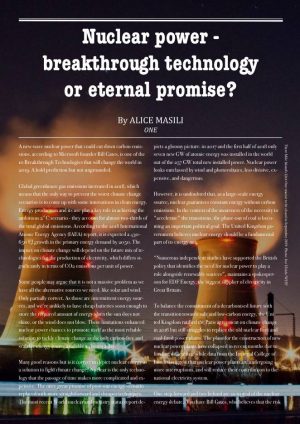 A new-wave nuclear power that could cut down carbon emissions, according to Microsoft founder Bill Gates, is one of the 10 Breakthrough Technologies that will change the world in 2019. A bold prediction but not ungrounded.
A new-wave nuclear power that could cut down carbon emissions, according to Microsoft founder Bill Gates, is one of the 10 Breakthrough Technologies that will change the world in 2019. A bold prediction but not ungrounded.
Global greenhouse gas emissions increased in 2018, which means that the only way to prevent the worst climate change scenarios is to come up with some innovations in clean energy. Energy production and its use play a key role in achieving the ambitious 2°C scenario – they account for almost two-thirds of the total global emissions. According to the 2018 International Atomic Energy Agency (IAEA) report, it is expected a 430-650 EJ growth in the primary energy demand by 2050. The impact on climate change will depend on the future mix of technologies for the production of electricity, which differs significantly in terms of CO2 emissions per unit of power.
Some people may argue that it is not a massive problem as we have all the alternative sources we need, like solar and wind. Only partially correct. As those are intermittent energy sources, and we’re unlikely to have cheap batteries soon enough to store the required amount of energy when the sun does not shine, or the wind does not blow. These limitations enhanced nuclear power chances to promote itself as the most reliable solution to tackle climate change as the only carbon-free and scalable energy source available 24 hours a day.
Many good reasons but is it correct to depict nuclear energy as a solution to fight climate change? Nuclear is the only technology that the passage of time makes more complicated and expensive. The once great promise of post-war energy scenario replaced with more straightforward and cheaper techniques. The most recent World nuclear and industry status report depicts a gloomy picture: in 2017 and the first half of 2018 only seven new GW of atomic energy was installed in the world out of the 257 GW total new installed power. Nuclear power looks outclassed by wind and photovoltaics, less divisive, expensive, and dangerous.
However, it is undoubted that, as a large-scale energy source, nuclear guarantees constant energy without carbon emissions. In the context of the awareness of the necessity to “accelerate” the transitions, the phase-out of coal is becoming an important political goal. The United Kingdom government believes nuclear energy should be a fundamental part of its energy mix.
“Numerous independent studies have supported the British policy that identifies the need for nuclear power to play a role alongside renewable sources”, maintains a spokesperson for EDF Energy, the biggest supplier of electricity in Great Britain.
To balance the commitment of a decarbonised future with the transition towards safe and low-carbon energy, the United Kingdom ratified the Paris agreement on climate change in 2016 but still struggles to replace the old nuclear fleet and coal-fired power plants. The plans for the construction of new nuclear power plants have collapsed in recent months due to funding difficulties, while data from the Imperial College of London suggest that nuclear power plants are undergoing more interruptions, and will reduce their contribution to the national electricity system.
One step forward and two behind are so typical of the nuclear energy debate. You have Bill Gates, who believes that the risk of failure of contemporary reactors can be solved entirely with the help of innovative systems – the Terra Power project, which he founded in 2006, has been working for some time to create a new type of reactor capable of burning nuclear waste produced by existing power plants. But his optimism is not shared by everyone. His views are counterbalanced by those who highlight the difficulties and risks associated with the construction of new generation reactors.
However, the debate is still very open among those who support nuclear power as the primary option between renewable energy and those who exclude it. If on the one hand nuclear power seems to be the path to follow; on the other, it has negative aspects. First of all, nuclear accidents. Though limited, they caused great fear – think of the Fukushima explosions in 2011 or the sensational Chernobyl disaster in 1986. In the wake of the Fukushima accident and long-standing problems related to excessive costs and financing in the nuclear sector, several countries are implementing a progressive elimination of nuclear in their energy-mix – among them Germany, Belgium, Scotland, Switzerland, Taiwan and South Korea.
Germany position is topical. Berlin recently stated that it would come out of coal by 2038. This decision marks the second most crucial energy breakthrough in Germany since the closure of the atomic power plants eight years ago. At that time, the Merkel government ordered the closure of half of the nuclear plants and the gradual shutdown of the other half by 2022. Since then, Germany has invested heavily in renewable energy, implementing the Energiewende, the energy transition, with excellent results in wind, solar, and biomass.
According to the German Association of energy producers, in the first six months of 2018, the production of green energy exceeded coal’s 118 TWh to 114 TWh. But getting out of the most polluting fossil fuel is not a cost-free process. It is quite expensive.
It is estimated that the transition will cost up to 80 billion euro. Half of the amount should be invested in the regions where the coal industry is still essential (mainly in the East) and will serve to retrain the sector’s workers destined to lose their jobs. The remaining forty billion will be used to prevent the increase in the electricity price and to preserve the competitiveness of the industry.
Nevertheless, the biggest problem is related to the storage of nuclear waste and its environmental impact: radioactive dross that takes thousands of years to decay and its safe conservation presents many risks. The issue is still an open question in the United Kingdom, where the contaminated material is temporarily stored at the Sellafield site in Cumbria. After 70 years of nuclear energy, there is still no permanent landfill to accommodate the most hazardous waste. But there is more than that. When a country decides to abandon fossil fuels and to replace them with nuclear energy, the first thing to do is to build new plants. Not so easy. And not only because it should face the constant adversity of the population living in the plant area.
Putting aside, for a while, the financial risk to experience double costs (due to a long-time frame, on average about ten years), there is another one related to the passage of time: when the nuclear plants are ready, the available technologies for solar and wind could be so advanced to have made nuclear useless or already obsolete.
According to scientist Ramez Naam, one of the leading experts in the field, providing solar panels to the roofs of all the buildings that could accommodate them, would meet half of our energy needs. In Europe alone, if the energy produced by the sun and wind is efficiently combined, 70-80% of energy needs would be matched. Furthermore, the continuous progress in the batteries field makes it easier to conserve and transport the energy produced by the sun. The other energy sources’ continuous technological advancement is the real challenger for nuclear power, the one that is likely to turn out Bill Gates prediction to be wrong.
Alice Masili



